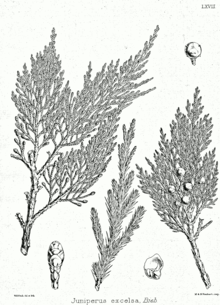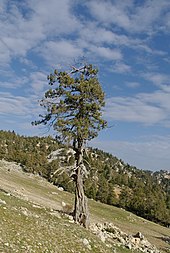Juniperus excelsa: Difference between revisions
m r2.7.2+) (Robot: Adding az:Hündür ardıc, udm:Juniperus excelsa |
+gallery |
||
| (38 intermediate revisions by 31 users not shown) | |||
| Line 1: | Line 1: | ||
{{Short description|Species of conifer}} |
|||
{{italic title}} |
|||
{{Speciesbox |
|||
{{Taxobox |
|||
| ⚫ | |||
| image = Juniperus excelsa ssp Bra68.png |
| image = Juniperus excelsa ssp Bra68.png |
||
| image_caption = ''J. excelsa'' subsp. ''polycarpos''<ref>1874 illustration from plate 68 of D. Brandis, Illustrations of the Forest Flora of North-West and Central India, 1874</ref> |
|||
| image_width = 240px |
|||
| status = LC |
|||
| image_caption = ''Juniperus excelsa'' subsp. ''polycarpos'' |
|||
| status_system = IUCN3.1 |
|||
| status_ref = <ref name="iucn status 12 November 2021">{{cite iucn |author=Farjon, A. |date=2013 |title=''Juniperus excelsa'' |volume=2013 |page=e.T42232A2964786 |doi=10.2305/IUCN.UK.2013-1.RLTS.T42232A2964786.en |access-date=12 November 2021}}</ref> |
|||
| regnum = [[Plant]]ae |
|||
| parent= Juniperus sect. Sabina |
|||
| divisio = [[Pinophyta]] |
|||
| ⚫ | |||
| classis = [[Pinophyta|Pinopsida]] |
|||
| |
| species = excelsa |
||
| ⚫ | |||
| familia = [[Cupressaceae]] |
|||
| |
| range_map = Juniperus excelsa range.svg |
||
| |
| range_map_caption = Distribution of ''Juniperus excelsa'' complex |
||
| binomial = ''Juniperus excelsa'' |
|||
| ⚫ | |||
}} |
}} |
||
'''''Juniperus excelsa''''' |
'''''Juniperus excelsa''''', commonly called the '''Greek juniper''', is a [[juniper]] found throughout the eastern [[Mediterranean Basin|Mediterranean]], from northeastern [[Greece]] and southern [[Bulgaria]] across [[Turkey]] to [[Syria]] and [[Lebanon]], [[Jordan]], the [[Caucasus]] mountains, and southern coast of [[Crimea]]. |
||
A [[subspecies]], ''J. excelsa'' subsp. ''polycarpos'', known as the '''Persian juniper''', occurs in the [[Alborz]] and other mountains of [[Iran]] east to northwestern [[Pakistan]], and an isolated population in the [[Jebel Akhdar (Oman)|Jebal Akhdar]] mountains of [[Oman]]; some botanists treat this as a distinct species, ''[[Juniperus polycarpos]]''.<ref>"''Juniperus polycarpos''" . ''The Plant List.'' Accessed 6 December 2020. [http://www.theplantlist.org/tpl1.1/record/kew-2332796]</ref> |
|||
| ⚫ | |||
==Description== |
|||
| ⚫ | |||
[[File:Juniperus excelsa - Greek juniper 01.jpg|upright|thumb|left|Greek juniper in southern Turkey]] |
|||
''Juniperus excelsa'' is a large [[shrub]] or [[tree]] reaching {{convert|6|-|20|m|abbr=off}} tall, rarely {{convert|25|m|ft|abbr=on}}. It has a trunk up to {{convert|2|m|ft|abbr=on|frac=2}} in diameter, and a broadly conical to rounded or irregular crown. The [[leaves]] are of two forms, juvenile needle-like leaves {{Convert|8–10|mm|frac=16}} long on seedlings, and adult scale-leaves 0.6–3 mm long on older plants. |
|||
| ⚫ | It is largely [[dioecious]] with separate male and female plants, but some individual plants produce both sexes. The [[conifer cone|cones]] are berry-like, 6–11 mm in diameter, blue-black with a whitish waxy bloom, and contain 3-6 [[seed]]s; they are mature in about 18 months. The male cones are 3–4 mm long, and shed their pollen in early spring. |
||
| ⚫ | |||
The [[Algum]] wood mentioned in the [[Bible]] may be from this species, but is not definitely so. |
The [[Algum]] wood mentioned in the [[Bible]] may be from this species, but is not definitely so. |
||
{{Clear left}} |
|||
==Gallery== |
|||
<gallery> |
|||
File:Greek juniper in Tisata Reserve, Bulgaria.jpg|''Juniperus excelsa'' specimen in [[Tisata]] reserve in southwestern Bulgaria |
|||
File:Cliff in Tisata Reserve.jpg|''Juniperus excelsa'' habitat in Tisata reserve |
|||
</gallery> |
|||
==References== |
==References== |
||
{{Reflist}} |
|||
* {{IUCN2006|assessors=Conifer Specialist Group|year=1998|id=42232|title=Juniperus excelsa|downloaded=12 May 2006}} |
|||
* {{cite iucn |author=Farjon, A. |date=2013 |title=''Juniperus excelsa'' |volume=2013 |page=e.T42232A2964786 |doi=10.2305/IUCN.UK.2013-1.RLTS.T42232A2964786.en |access-date=12 November 2021}} |
|||
*Adams, R. P. (2004). ''Junipers of the World: The genus Juniperus''. Victoria: Trafford. ISBN 1-4120-4250-X. |
|||
* |
*Adams, R. P. (2004). ''Junipers of the World: The genus Juniperus''. Victoria: Trafford. {{ISBN|1-4120-4250-X}}. |
||
*Farjon, A. (2005). ''Monograph of Cupressaceae and Sciadopitys''. Royal Botanic Gardens, Kew. {{ISBN|1-84246-068-4}}. |
|||
*[http://www.conifers.org/cu/ju/excelsa.htm Gymnosperm Database: ''Juniperus excelsa''] |
|||
*{{Gymnosperm Database|family=Cupressaceae|genus=Juniperus|species=excelsa}} |
|||
*[http://www.pinetum.org/PhotoMPF/junexc.gif photo of tree in southwest Turkey] |
*[http://www.pinetum.org/PhotoMPF/junexc.gif photo of tree in southwest Turkey] |
||
==External links== |
|||
{{Commons category-inline}} |
|||
* [http://www.euforgen.org/species/juniperus-excelsa/ ''Juniperus excelsa''] - information, genetic conservation units and related resources. [[European Forest Genetic Resources Programme]] (EUFORGEN) |
|||
{{Taxonbar|from=Q773892}} |
|||
[[Category:Juniperus|excelsa]] |
[[Category:Juniperus|excelsa]] |
||
[[Category: |
[[Category:Flora of Europe]] |
||
| ⚫ | |||
[[Category:Least concern plants]] |
[[Category:Least concern plants]] |
||
[[Category:Flora of |
[[Category:Flora of Bulgaria]] |
||
| ⚫ | |||
[[ar:عرعر المرتفعات]] |
|||
[[az:Hündür ardıc]] |
|||
[[de:Griechischer Wacholder]] |
|||
[[fr:Genévrier grec]] |
|||
[[hr:Foja divlja]] |
|||
[[he:ערער ברושי]] |
|||
[[la:Juniperus excelsa]] |
|||
[[no:Gresk einer]] |
|||
[[ru:Можжевельник высокий]] |
|||
[[udm:Juniperus excelsa]] |
|||
Latest revision as of 14:43, 14 February 2024
| Juniperus excelsa | |
|---|---|

| |
| J. excelsa subsp. polycarpos[1] | |
| Scientific classification | |
| Kingdom: | Plantae |
| Clade: | Tracheophytes |
| Clade: | Gymnospermae |
| Division: | Pinophyta |
| Class: | Pinopsida |
| Order: | Cupressales |
| Family: | Cupressaceae |
| Genus: | Juniperus |
| Section: | Juniperus sect. Sabina |
| Species: | J. excelsa
|
| Binomial name | |
| Juniperus excelsa | |

| |
| Distribution of Juniperus excelsa complex | |
Juniperus excelsa, commonly called the Greek juniper, is a juniper found throughout the eastern Mediterranean, from northeastern Greece and southern Bulgaria across Turkey to Syria and Lebanon, Jordan, the Caucasus mountains, and southern coast of Crimea.
A subspecies, J. excelsa subsp. polycarpos, known as the Persian juniper, occurs in the Alborz and other mountains of Iran east to northwestern Pakistan, and an isolated population in the Jebal Akhdar mountains of Oman; some botanists treat this as a distinct species, Juniperus polycarpos.[3]
Description
[edit]
Juniperus excelsa is a large shrub oder tree reaching 6–20 metres (20–66 feet) tall, rarely 25 m (82 ft). It has a trunk up to 2 m (6+1⁄2 ft) in diameter, and a broadly conical to rounded or irregular crown. The leaves are of two forms, juvenile needle-like leaves 8–10 millimetres (5⁄16-3⁄8 in) long on seedlings, and adult scale-leaves 0.6–3 mm long on older plants.
It is largely dioecious with separate male and female plants, but some individual plants produce both sexes. The cones are berry-like, 6–11 mm in diameter, blue-black with a whitish waxy bloom, and contain 3-6 seeds; they are mature in about 18 months. The male cones are 3–4 mm long, and shed their pollen in early spring.
It often occurs together with Juniperus foetidissima, being distinguished from it by its slenderer shoots 0.7–1.3 mm diameter (1.2–2 mm diameter in J. foetidissima), and grey-green, rather than mid green, leaves.
The Algum wood mentioned in the Bible may be from this species, but is not definitely so.
Gallery
[edit]-
Juniperus excelsa specimen in Tisata reserve in southwestern Bulgaria
-
Juniperus excelsa habitat in Tisata reserve
References
[edit]- ^ 1874 illustration from plate 68 of D. Brandis, Illustrations of the Forest Flora of North-West and Central India, 1874
- ^ Farjon, A. (2013). "Juniperus excelsa". IUCN Red List of Threatened Species. 2013: e.T42232A2964786. doi:10.2305/IUCN.UK.2013-1.RLTS.T42232A2964786.en. Retrieved 12 November 2021.
- ^ "Juniperus polycarpos" . The Plant List. Accessed 6 December 2020. [1]
- Farjon, A. (2013). "Juniperus excelsa". IUCN Red List of Threatened Species. 2013: e.T42232A2964786. doi:10.2305/IUCN.UK.2013-1.RLTS.T42232A2964786.en. Retrieved 12 November 2021.
- Adams, R. P. (2004). Junipers of the World: The genus Juniperus. Victoria: Trafford. ISBN 1-4120-4250-X.
- Farjon, A. (2005). Monograph of Cupressaceae and Sciadopitys. Royal Botanic Gardens, Kew. ISBN 1-84246-068-4.
- Earle, Christopher J., ed. (2018). "Juniperus excelsa". The Gymnosperm Database.
- photo of tree in southwest Turkey
External links
[edit]![]() Media related to Juniperus excelsa at Wikimedia Commons
Media related to Juniperus excelsa at Wikimedia Commons
- Juniperus excelsa - information, genetic conservation units and related resources. European Forest Genetic Resources Programme (EUFORGEN)



